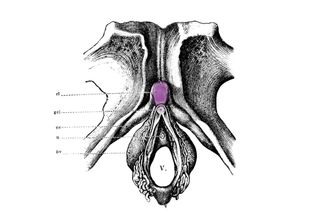
New Study Suggests the Clitoris Has a Reproductive Function
A new literature review claims that stimulating the clit physiologically prepares the female body to receive sperm.

We have barely begun to understand the complete function of the clitoris, and whether it is but an evolutionary remnant — kind of like nipples on men. What we know with some certainty, though, is that a) most women who orgasm, do so clitorally, and b) the clitoris plays no discernible role in reproduction, since the female orgasm plays no such part, unlike its male sperm-bearing counterpart. Maybe.
First, let’s look at the clitoris — widely understood as a little knob sitting atop the vulva, it’s been found to be a huge organ that resides both inside and outside the body. Only 10% of the clitoris is as we know it (called the glans clitoris), and 90% of it extends into the pelvis, encircling the vagina, in a system of blood vessels and nerves. It looks like a plump wishbone and is made up of erectile tissue. Roy Levin, MSc, PhD, recently published a literature review in Clinical Anatomy and came to the conclusion that the clitoris is, in fact, vital for the reproduction process. The review notes that stimulating the glans clitoris right above a woman’s vulva activates the brain to bring about changes in the female reproductive tract, in anticipation of sexual intercourse, and therefore, the possibility of sperm entering the uterus. Should that happen, the brain ensures that the female body is prepared to receive and process it.
The changes the brain brings about include increased vaginal lubrication, blood flow, oxygen levels, and temperature, and decreased levels of vaginal acidity. Significantly, stimulating the clitoris also leads to vaginal tenting, a phenomenon that occurs when a woman is turned on; her uterus is pulled upward, making the vagina longer, and shifting the position of the cervix. The body does so, in an attempt to bring the cervix — the entrance to the uterus — away from the semen pool to prevent sperm from entering into the uterus too rapidly, giving it time to become mobile and mix with female genital fluids. Levin’s literature study also suggests that stimulating the clitoris results in vaginal ballooning, which also occurs when a woman is turned on and results in the vagina becoming wider and more engorged in the anticipation of receiving a penis hospitably.
“All these genital changes taken together are of major importance in facilitating the possibility of reproductive success (and thus gene propagation) no matter how or when the clitoris is stimulated—they reveal its overlooked reproductive function. Of course, also commensurate with these changes, is its activation of sexual pleasure. The clitoris thus has both procreative (reproductive) and recreative (pleasure) functions of equal importance,” Levin says in the review.
Related on The Swaddle:
The Importance of Orgasms, from Women Who Don’t Have Them
Here’s the thing though: this review by the retired U.K. scientist is controversial at best, since, despite continuous attempts to study the clitoris, no scientific basis has been accorded to its reproductive capabilities. Most of the research he cites — as a basis for the various physiological changes in a woman’s reproductive tract that stimulating the clitoris brings about — are studies he’s been a part of over the last few decades himself, so pardon us for the grain of salt held firmly. Also, some of the changes he claims the clitoris is responsible for, occur when a woman is aroused — which doesn’t necessarily require clitoral stimulation. Women can be turned on even without or before stimulating the clitoris. It’s just that probably because of how pleasurable it feels for women, it is usually a part of the process of arousal and foreplay. Stimulating the clitoris leads to orgasm in most women, if not all, but since we don’t know if the female orgasm plays a part in reproduction either, the clitoris’ role remains as dubious as ever.
Levin also discusses how female genital mutilation creates a “reproductive disability” in survivors, implying this is a result of circumcision of the glans clitoris, one of the kinds of FGM still practiced in many countries across the world. However, he cites no evidence for this. There have been some studies that suggest fertility declines after FGM, but even this evidence is not constant between studies. Evidence of a link between the two is the strongest when along with the glans clitoris, parts of the labia are also removed and then stitched together, narrowing the vaginal opening, which can introduce a host of other reasons for infertility.
“The often repeated mantra, that the sole function of the clitoris is to induce sexual pleasure, is now obsolete. The concept changes a major sexual belief, and the physiological evidence is now obvious,” concludes Levin, but his claim can be easily refuted with the science we know until now. It doesn’t mean he is wrong — it just means his theory needs to be investigated further. Which works out, because (male) scientists, at their end, are not going to stop until they figure out why exactly the clitoris exists — apart from providing pleasure for a woman. Because that reason is just not good enough, is it?
Pallavi Prasad is The Swaddle's Features Editor. When she isn't fighting for gender justice and being righteous, you can find her dabbling in street and sports photography, reading philosophy, drowning in green tea, and procrastinating on doing the dishes.
Related


The Difference Between Feeling Panic and a Panic Attack
